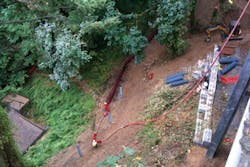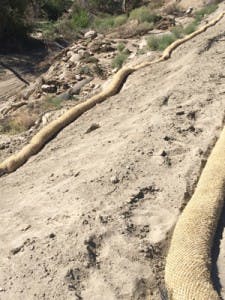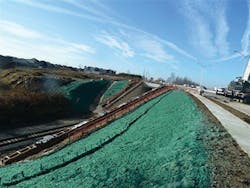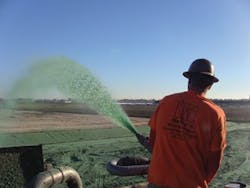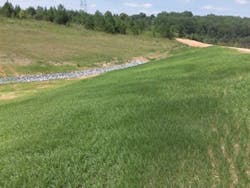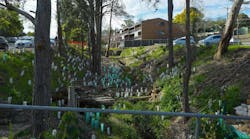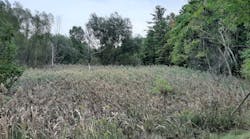Hydroseeding: Protecting the Soil and the Future
Timing hydroseeding correctly requires balance and planning. Today, contractors like Brian Young, general manager of Fox Erosion Control & Landscape Inc. based in Clackamas, OR, are fast approaching the last seeding window of the year as set for his region by the Oregon Department of Transportation: September 1 through October 31. For many erosion control companies, this is a last chance to plan their site protection, with combinations of erosion control methods spun out in scenarios that keep soil in place and public concerns at bay.
Highways: A View From the Shoulder
When erosion from highway construction poses a risk to residential areas, sediment control can find itself in the public spotlight. Begun in October 2010 and completed in December 2014, the I-5 Southwest Iowa Street Viaduct project located on approximately 6 acres in Portland, OR, included the replacement of “a large section of I-5 situated approximately 150 feet above a ravine that fed into an affluent neighborhood in the Portland area,” describes Young. Located south of downtown Portland, the project maintained a high level of visibility throughout.
“A lot of state officials drove by that job every single day. There was a lot of public awareness prior to and during construction. They had public liaisons full-time basically heading off [any issues]. Importantly, they were keeping the public apprised,” says Young, adding that many residences could have been affected if erosion control measures failed. “You’ve got to picture this massive hillside that could end up in somebody’s backyard. There were a lot of people that had their eyes on this project. The project was very sensitive to sediment-laden runoff and soil erosion due to excavation associated with bridge and wall construction taking place directly above the neighborhood.”
Fox Erosion Control worked as a subcontractor on the project. The project owner was the Oregon Department of Transportation.
“Our portion of the erosion control work started out as a straw mulching; we were pneumatically applying straw on exposed soils,” says Young. “With this project being located on I-5 with non-stop, fast-moving traffic and the deep ravine below the new stretch of freeway, it created a Venturi effect, and the straw was being blown away.”
Soon, the state recognized this tactic wouldn’t be a successful measure.
“This was not something they were going to attack on a wet-weather or monthly basis. This was a weekly visit for us. Every single Friday, after earthwork ceased, we’d be called in to apply heavy applications of flexible growth medium to all exposed excavations,” says Young. “From an operational standpoint, we had a lot of precarious spots we had to get into, a lot of very steep, exposed cut and fill slopes, and a lot of traffic. Our equipment operators were located on the top deck of the hydroseeding equipment shooting all cut and fill slopes from the shoulder of Interstate 5.
“Of course, all traffic control devices were in place. However, it definitely gets the blood pumping when cars are zipping by at 70 miles per hour, and more than likely watching our large seeding equipment shooting ‘the green stuff’ 150 feet up a cut slope!”
Approximately $180,000 of the project’s budget was associated with change order work for controlling runoff and slope stabilization, according to Young.
There were two basic seed mixes employed at the site. Young says the roadside mix included Achillea millefolium, Anaphalis margaritacea, and Bromus carinatus, and the second mix included Elymus glaucus, Lupinus polyphyllus, Solidago canadensis, Triticum elytrigia. Fox Erosion Control also used a mycorrhizal inoculant called Eco-Live that was added to the seed mixture. All of these had to be on a qualified products list and approved for use by the state.
The company used a large Finn Corp. Finn T-330 for hydroseeding and a Finn BB-1222 bark blower for installation of compost erosion blankets, socks, and berms. The flexible growth medium was Flexterra from Profile Products.
“The hydraulically applied material was specified at a very high application rate,” says Young. “With the viscosity, it was imperative to have the agitation devices and pumping capabilities of the Finn equipment. In my opinion, the performance of the Finn equipment is like none other in the industry.”
Accessibility was also an issue for a CalTrans October 2014 road blowout repair and revegetation project on State Route 74 in Hemet, CA.
Ramon Godinez, an erosion control and geosynthetics specialist at Ewing Irrigation based in Riverside, CA, says the site was not accessible using big equipment. In addition, he notes, the site’s soil condition “was a big challenge: poor nutrient value in the soil in combination with very erosive, sand-dominant soils.”
To stabilize the site, the company selected a product from Organic Earth Industries. “It’s an innovative product that combines a hydraulic growth medium and mulch in one bag,” he says.
With a very small window to apply the material because of a rainstorm predicted within a few days, says Godinez, a combination of hydroseeding techniques were employed.
“We used fiber rolls to control run-on from the road above and also in the middle of the slope to hold back any initial erosion from sandy soils. We used a slurry mix of Organic Earth Industries’ Omega HGM2, Quantum Growth’s Quantum-VSC and Quantum-Light bacteria, and an organic 4-4-4 fertilizer to give this project the best chance for vegetation sustainability.”
This decision ultimately made a positive impact on the overall cost for erosion control for the site.
“The estimated cost for this project was approximately $12,000, which was a bargain to the state because the other option would have been to lug in and spread compost or topsoil on steep hillside, then apply a BFM [bonded fiber matrix] type of hydromulch to control erosion,” says Godinez. “The revegetation goal was to get something—anything—to grow on this slope, because the state had never been successful in establishing much vegetation on this particular area of highway.”
A project along
California’s State Route 74
Bridge Replacement and Difficult Access
Bridge replacement projects are gaining attention not only across the United States, but also just over the border in Canada. The Sarnia Road bridge replacement took place in the fall of 2011 in London, Ontario. JK Landscape Inc., also based in London, used a Bowie Imperial 3000 Hydro-Mulcher to revegetate the site.
“The Sarnia Road Bridge replacement had its own unique challenges. The areas to be hydroseeded were adjacent to a new bridge over an existing rail line. The terrain consisted of steep slopes and swales leading down to the rail line,” explains John Kochanowski, owner of JK Landscape. “This was a late fall dormant seeding scenario, and erosion control was the main focus of the project. The soil had to be maintained for the winter period of approximately four months to protect the rail line and keep the slopes from causing a rail accident.”
It the early planning stages, the hydroseeding techniques considered were not extensive.
“However, after consulting with the city engineers and with the help of our industry partner, Quality Seeds, a more comprehensive plan was formulated,” according to Kochanowski. “Both Terra-Tubes, for water management and slope interruption, and Enkamat turf reinforcement mats were installed in the most problematic areas. Flexterra HP-FGM was substituted for regular cellulose mulch to ensure that the erosion control would function properly over the winter months. Along with a custom native seed mix and cover crop, a plan was developed to prevent soil or sediment loss reaching the rail line. Silt fencing and straw bales were used to augment the erosion control measures.”
Terra-Tubes installed near the Sarnia Road site
Experience with Bowie equipment influenced the decision to use it on this project.
“JK Landscape Inc. has used Bowie machines since the company’s inception. Reliability and power were the basis for our choice,” notes Kochanowski. “Bowie equipment has consistently delivered the reliability that we require to complete our work efficiently. Today’s construction industry demands equipment and services that deliver the goods on time and on budget. Bowie fits the bill.”
The project, which cost approximately $35,000, may have used a complex web of solutions to achieve its goal, but its purpose was clear and straightforward from start to finish.
“The revegetative goal for this project, although daunting, was really quite simple: prevent soil and sediment from reaching the rail line,” says Kochanowski. “The site itself was challenging, with steep slopes and swales. However, the combination of Flexterra HP-FGM, Enkamats, Terra-Tubes, excellent seed mixes, and the Bowie equipment proved to be a winning combination. The following spring resulted in excellent germination and no soil loss.”
Mining: Overcoming Soil Hurdles
Normand Cossette, president of Irrigation NORCO Inc. based in Quebec, says his company has been working since 1996 on a variety of mining sites located in Fermont (in Quebec) and Wabush and Labrador City (in the province of Newfoundland and Labrador). Each of these mining regions has similar challenges in terms of revegetation.
“The extremely low fertility level of the medium of growth [results from] metalliferous mill tailings, from local iron ore bodies with high silica content,” says Cossette. This means the area is “usually totally sterile and solely mineral, with 0% organic matter. Some microelements are too abundant, namely manganese and iron, and we must discard plant species that do not tolerate high manganese and iron content in the soil.”
Climate also poses a challenge in these regions. “One must select species with outstanding winter hardiness, species able to survive minus 45 degrees Celsius,” says Cossette, adding that the hardiness zone for this area’s landscaping purposes is 0 to 1a or 1b.
Revegetation goals for these sites are straightforward, he says: “To grow permanent, perennial, self-sustaining herbaceous vegetation, and to turn the sterile and solely mineral media of growth into a fertile soil, into a genuine living soil.”
Accomplishing this goal has meant embracing various hydroseeding techniques at the sites.
“To grow successfully herbaceous vegetation upon mining wastes, overburden material, and tailings sand, we use three different techniques, depending on the slope and surface conditions—for example, a smooth, cultivable surface versus a rocky or gravelly surface, or a gentle slope versus a steep slope. One is broadcast spreading of seeds plus harrowing plus fertilizer. The second is to spread hay mulch plus ‘crimp’ hay mulch plus direct, precision drill-seeding plus fertilizer(s), broadcast spread. The third, wherever a farm tractor cannot travel safely, is hydroseeding.” Of these three techniques, he says, hydroseeding is the most expensive one, and the per-hectare or per-acre cost is adjusted according to the number of “coats” of hydroseeding slurry sprayed upon the surface.
The company owns five trailer-mounted hydroseeding machines in the 1,050- to 1,250-gallon range and one larger 3,300-gallon machine Cossette refers to as “our Hulk.” He describes the Epic Mfg. Easy Lawn units, dating from 2004 and 2006, in particular as “highly reliable and versatile.” The all-hydraulic operation, paddle wheel agitator, and slurry pump—hence no clutch to operate—means they are safer for workers to operate, he says, and the stainless steel tank and agitator rotor makes them rust and corrosion free. He also has found the hose reel located at the back of the trailer appealing.
In the fall of 2014, Mountain Hydroseeding began an ongoing battle with erosion on a very steep slope near strip mines in Berry County, KY.
“There was some erosion happening, and they decided to fix it with a bulldozer and seed it,” says Boyd Brock, owner of Mountain Hydroseeding based in Pineville, KY. With a revegetation goal of 95% grass for the 2-acre site, the company used a Caudill Seed mix that included red clover, white clover, Kentucky 31 fescue, and Korean lespedeza on the site.
“They always give us a good product, and if we need any other kind of support from them it’s always there,” says Brock. “We got a really good grass blend.”
The selection of grass seed mix for a site like this requires careful consideration. “It depends on the permit package and the post-mining land use,” explains Kevin Howard, environmental quality control manager at Caudill Seed’s Allen, KY, branch. “When they get issued a permit, they receive a permit package. It lets you pick out of several species what you will use on the site.
“These are grasses that are approved by the Division of Mining Permits. They allow alternatives if you can’t get [the ones on the list]. You can get those approved, too. There are many steps in a revegetation plan.”
Orchard grass, timothy grass, clovers, and fescues are commonly used for revegetating mining sites in the region, as is winter rye. Howard says an annual grass is added to hold the soil in place.
Although Brock says the area didn’t experience considerable rain at the time of application, a variety of erosion control methods were employed.
“For erosion control we used runoff ponds, we used all-weather mulch in our seeding, and we use rock ditches,” he says. “Everything was put back on the slope, and it worked out.”
Residential Protection: Combining Proven Methods
The need to protect residential areas from soil erosion also played a role in hydroseeding planning at a 25-acre site in Carlsbad, CA, in 2014.
In a region where wild areas are becoming scarce because of continuing development, revegetating an area damaged by wildfire is, of course, a sensitive process.
“This is a unique ecosystem called a coastal sage scrub community and chaparral,” explains Rob McGann, president of HydroPlant Hydroseeding Inc., based in San Marcos, CA. “It’s pretty widely distributed here in southern California. The fire burnt so intensely there was no vegetation left.”
A distribution center site in California
In October 2014, the company began hydroseeding work on the open-space areas of the site that burned adjacent to local homes.
“[The homeowners association] put in a claim to their insurance for it,” says McGann. “We went in in two different phases, a total of 10 working days.”
Timing of the project was crucial.
“Part of the reason they timed the work for the fall was to take advantage of the rains,” says McGann. “It’s all non-irrigated. We’re leaving it up to Mother Nature.”
The company applied Spokane, WA-based Fiber Marketing International’s wood fiber mulch; Ranchester, WY-based Rantec Corp.’s SpecTac binder; and a coastal sage scrub mix for the revegetation, which is expected to take approximately three to five years.
“The access was extremely challenging because there are canyons,” says McGann, noting that workers could approach the area using a hose. “They’re not very deep, but they are extreme. Some are so sheer you can’t even walk on them, so you need a nozzle on the top.
“In applying the hydraulic matrix on the soil, in some areas ash can be six to eight inches deep. It’s not easy dragging a hose and walking through it. They guy doing the spraying has a knack for it. It’s a visual and a sensory thing. He can see when the ash is settling down. He might have to go over a given area four or five times.”
Unexpectedly, a rainstorm struck right after the treatment.
“In the areas untreated ashflow there was some runoff so they decided to go in and do those areas too,” says McGann. “It’s germinating as we speak. We got it 100% covered.”
The V.C. Summer Nuclear Generating Station site
Nuclear Site Construction: Meeting the Requirements
Meeting permit requirements is just part of the daily routine most erosion control specialists face on their job sites. When the new construction site is part of a nuclear power plant, however, there is nothing routine about following the extensive regulations and requirements that can be challenging.
The V.C. Summer Nuclear Generating Station is a $10 billion power plant project in Jenkinsville, SC. Protective soil stabilization has been carried out at Units 2 and 3 of the site by Mount Pleasant, NC-based Philen Construction since 2009.
“Nuclear construction is recognized as special and unique,” explains Karen Kieffer, owner and president of Philen Construction. “V.C. Summer is approximately 1,800 acres of new nuclear construction. The nuclear culture in itself puts it in a category very few will experience.
“The challenges are also unique. Work is effectively planned and executed by incorporating job site conditions and the need for coordination with different groups and job activities. There are strict guidelines that must be followed, and revegetation is no exception.”
Although the company first considered using blankets for erosion control, Flexterra, a hydraulically applied flexible growth medium from Profile Products, was selected to meet the areas’ specific needs.
“Flexterra is ideal for establishing long-term soil and slope protection. It is environmentally friendly, it bonds directly with the soil, and it is immediately effective,” says Kieffer. “Our goal is simple—meet and/or exceed these guidelines. We worked with the engineers to achieve just that.
“Nuclear culture and traits are ‘only the best of the best.’ To achieve the ‘best’ we used a combination of hydraulically applied products: Pennington Seed site-specific mix, Uflexx fertilizer, NeutraLime Dry, BioPrime, JumpStart, and Flexterra.”
The seed mix used, which includes fescue, Bermuda, bahia, love grass, lespedeza, and annual grasses, is custom blended by Pennington, notes Kieffer. The product is part of the project’s erosion control budget, estimated at $2 million.
In addition to working to meet strict rules and regulations at the site, Daryl Philen, EHS/operations manager of Philen Construction, notes, “Maneuvering large equipment safely to achieve desired results due to the varying topography is the most challenging aspect.”
Skill in this area is achieved through practice. “Philen Construction is experienced in hydroseeding techniques and the many variables such as safe access to areas, soil conditions, slope length, and appropriate mix of products for optimum stabilization and growth,” says Kieffer.
The project is estimated to be complete in 2020. “Philen plans on being onsite when they turn the lights on,” says Kieffer.
Commercial Construction Challenges
Custom Gardens, based in Amarillo, TX, worked to establish grass at a new truck wash near I-40 in Amarillo, TX, in the fall of 2014. With an erosion control budget of $12,000, the company raced against time to seed the sloped area.
“We used a combination of Bermuda and annual rye, because it was the middle of October and our first freeze is usually the last week of October. I knew the rye would germinate fast, and if the Bermuda would germinate, it might not survive the first freeze. We seeded on a Friday and it was up the following Monday,” says Brooke Furrh, owner of Custom Gardens. “We used some erosion control blanket in the drainage swale where there was a lot of slope and no irrigation.”
The hydromulch combination included wood fiber mulch; seed; fertilizers including Ecologel Solutions’ CytoGro, a biostimulant; and Slicky Sticky tackifier, says Furrh. “CytoGro is added to all of our hydromulch to help grass seed establish faster.”
Overall, Furrh is pleased with the outcome. “We got the grass up and it is still looking good,” he says.
Irrigation also can also prove to be a hydroseeding challenge, as was the case for an acre of slope at Erie Bank on Interchange Road in Erie, PA, in 2013. According to Stephanie Shattuck, vice president of Country Landscape Inc., also based in Erie, the site was located on a hill with no way to irrigate the newly applied seed. Runoff was a concern.
“It was approximately 2:1,” she says. “I could hardly stand on it.”
The company decided to use Lesco Triplescape seed mix with Lesco Moisture Manager, which draws water molecules into plant roots, in the hydroseeding tank, basing the decision on the success others had using the product. “We planted it with an annual grass to hold the seed in place, for the other seed to germinate,” says Shattuck. The company also used erosion control blankets as part of the erosion control plan, which had a total budget of around $2,500.
“It worked out really well,” says Shattuck. “We didn’t have a lot of rain.”
On one California commercial site, however, weather added to construction challenges.
Pacific Cycle is building a 10-acre West Coast bicycle distribution center next to Selano County Airport in Vacaville, CA. The 40-acre site included 30 acres of exposed dirt adjacent to a few creeks.
“The challenging thing was that the site had its own internal drain system that took water from all around the project that put it into a channel in the back of the project,” explains Jay Selby, president and owner of Selby’s Soil and Erosion Control Company based in Newcastle, CA. “Drainage eventually flowed to a creek.”
Nothing had been done at the site, he says, when a massive storm struck in December 2014, dropping 5 inches of rain.
“At this time there was no roof or walls on the concrete building. We had not been contracted at this point. There was equipment stuck everywhere. It was a little unexpected,” notes Selby. “The sediment and dirt that came off the site filled the channel with three feet of sediment. Dirty water drained into the neighboring creek. It was a big, big problem.”
At that point the owner was given two weeks by the water-quality control board to apply erosion control on the entire site or face massive fines.
Wattles were used to filter the water and slow it down as it left the site, and erosion control blankets and silt fencing were also added.
“In the channel we installed rock check dams as water dissipated,” says Selby. “The entire site was hydroseeded with [Fiber Marketing International’s] Rainiers Bonded Fiber Matrix Supreme. Depending on slope variation and how much water was going to be travelling through the site, we varied the application from 2,500 pounds to 3,500 pounds of bonded fiber matrix over the 30-acre site. One of the challenges we faced is that the site never really dried up. It was still a muddy mess when we were out there. It was just the nastiest mud I’ve ever seen, and the tractors that had been driving though it during the rain event just made it a very undulating surface. It was still very, very muddy.”
Sediment control was not the only problem workers faced. “When you build such a large concrete building, it creates a high pH level. As water drains off the site, the high pH levels could kill fish,” says Selby. “On top of this, the site also used a lime treatment.”
Filtration would be needed to curb this threat and to lower pH levels in the water before runoff left the site. The company worked with a $150,000 erosion control budget for the 10-day project. Selby says the company chose the Rainier BFM because of its “outstanding performance” on a site with challenges like this.
“In conjunction with BFM, we used polyacrylamides. Our goal was to trap soil particles and lower the pH level in the soil before it left the site. We used a compost wattle then put a riprap check dam over the top of compost wattle,” explains Selby. “The riprap held the wattle in place. As the water filters through the compost wattle, it helps reduce the amount of pH leaving the site.”
Solutions like this are examples of how challenges continue to be met in the modern hydroseeding industry.
“We have chosen products out of a process of elimination over the years,” says Selby, who notes that sometimes you have to wait to see what is working and what is not in rain events like the one that occurred in Vacaville. “You really never know until you try. This whole industry was built on innovation.”